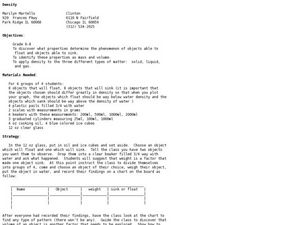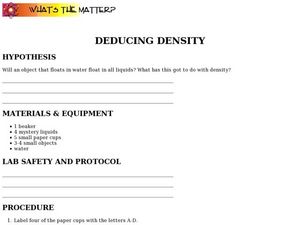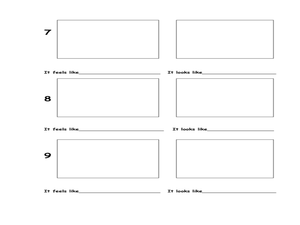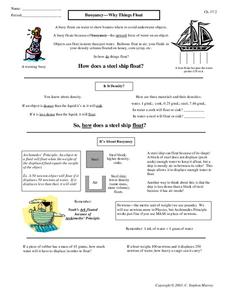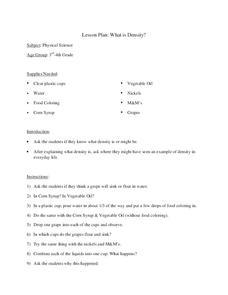Curated OER
The Water Cycle/States of Matter
High schoolers engage in a lesson that is concerned with the water cycle and different states of matter. They conduct research using a variety of resources in preparation for taking a quiz. Then students take the quiz in correlation to...
Curated OER
The Weight of Water
Students examine how salt water is more dense than fresh water through experimentation with eggs.
Curated OER
Buoyant Boats
Students design and construct a boat out of aluminum foil and a few other simple materials. The boats then be tested by floating them in water, then adding mass until they sink. They explore the various shapes of boat construction.
Curated OER
Sink It
Introduce your class to the concept of sinking and floating. In groups, they classify objects after making predictions about which materials will sink or float. They record their results and create graphs and charts to share with the class.
Curated OER
Seashore Explorers
There are three separate lessons within this resource that can be used together, or that can each stand alone. In the first, five simple activities allow junior scientists to examine the amazing properties of water. In the second, they...
California Academy of Science
Buoyancy Bulls-Eye
Why does a seastar sink, but a jellyfish float? Through a fun investigation, learners examine the concept of buoyancy using simple household items. The challenge: create neutral buoyancy for an action figure in water. With ample...
Teach Engineering
Rock and Boat
Present the class with a question on whether the water level of a pond will rise they take a large rock out of a boat and drop it into the pond. Groups come down on all sides of the question and try to justify their answers. The activity...
Curated OER
Activity # 13 Float or Sink?
Students have seen that solids, which are more dense than a liquid, that sinks in that liquid and solids, which are less dense than a liquid, that floats on that liquid. They use a metal boat to float in water. Pupils comprehend that...
Curated OER
Floating
First graders discuss with the teacher if everything will float in water. They observe a marble and determine whether it will float making predictions as a class. After observing the results, they discover that liquids exert an upward...
Curated OER
Salinity
Learners define and discuss salinity, conduct classroom experiment to determine salinity of water sample by using hydrometer, record predictions, and demonstrate understanding of how salinity influences object's ability to float in water.
Curated OER
Density: Float or Sink
Students discover density. In this density lesson, students discover the properties of objects that allow them to float or sink in water.
Curated OER
Sink or Float
Third graders sort objects into those they think will float and those that will sink and test their predictions. They experiment with clay molding it into shapes that float. They place pennies in them until they sink. They test other...
Curated OER
Deducing Density
In this deducing density learning exercise, students follow the procedures to set up an experiment about objects floating in water and liquids of different densities, answer questions, collect data and complete charts.
Curated OER
Exploring Marine Objects
Students identify the sources of water on Earth. In this life science lesson, students list the different plants and animals that live in the ocean. They explore marine objects in the lab and draw them.
Curated OER
Floating Pencil
Students discover how salt water makes a pencil float better than freshwater by measuring and comparing the lengths of the portion of the pencil that floats above the water surface. They then determine if an unknown water sample is...
Curated OER
Incredible Iceboats
Students explore the concept of floating objects (ice). In this floating lesson, students conduct an investigation in which they hypothesize about the time that an ice boat will last floating in water. Students record their...
Curated OER
Float or Sink?
Students examine why some objects float while others do not. They place various objects in water to observe their floating capability. Students record the object, its weight, and if the object floated. They construct a graph plotting...
Curated OER
Buoyancy
In this buoyancy worksheet, students read about why objects float or sink. Students apply the Archimedes' Principle in a buoyancy lab. Students complete 1 graphic organizer.
Curated OER
To Float or Not to Float, That is the Question?
Ninth graders develop operational definition of density, do computations using density equation, categorize pieces of matter as being able to float on
water or not, based on density, explain why some objects sink or float based on...
Curated OER
What is Density?
Young scholars explore physical science by conducting an in-class experiment. In this density lesson plan, students define vocabulary terms dealing with physics and discuss their knowledge of density. Young scholars conduct several "sink...
Curated OER
Fun with Surface Tension!
Students explore physical science by participating in a water properties experiment. In this surface tension lesson, students utilize pennies, water, a dropper and soapy water to test the different surface tensions with numerous objects....
CK-12 Foundation
Going Fishing
Why do some things float and others sink? A creative simulation allows learners to adjust mass and volume of an object to affect its buoyancy in water. A graph records the effect of each manipulation.
Curated OER
Floating and Sinking
In this early physics activity, students cut out pictures of 16 everyday objects. Students determine whether each of the objects will float or sink and then paste the pictures in the appropriate boxes.
Curated OER
Technology of the Deep: Experiments with Buoyant Forces
Students conduct a series of experiments to study the effects of temperature and salinity on the buoyancy of an object in water. They devise ways to make floating and sinking objects neutrally buoyant.










